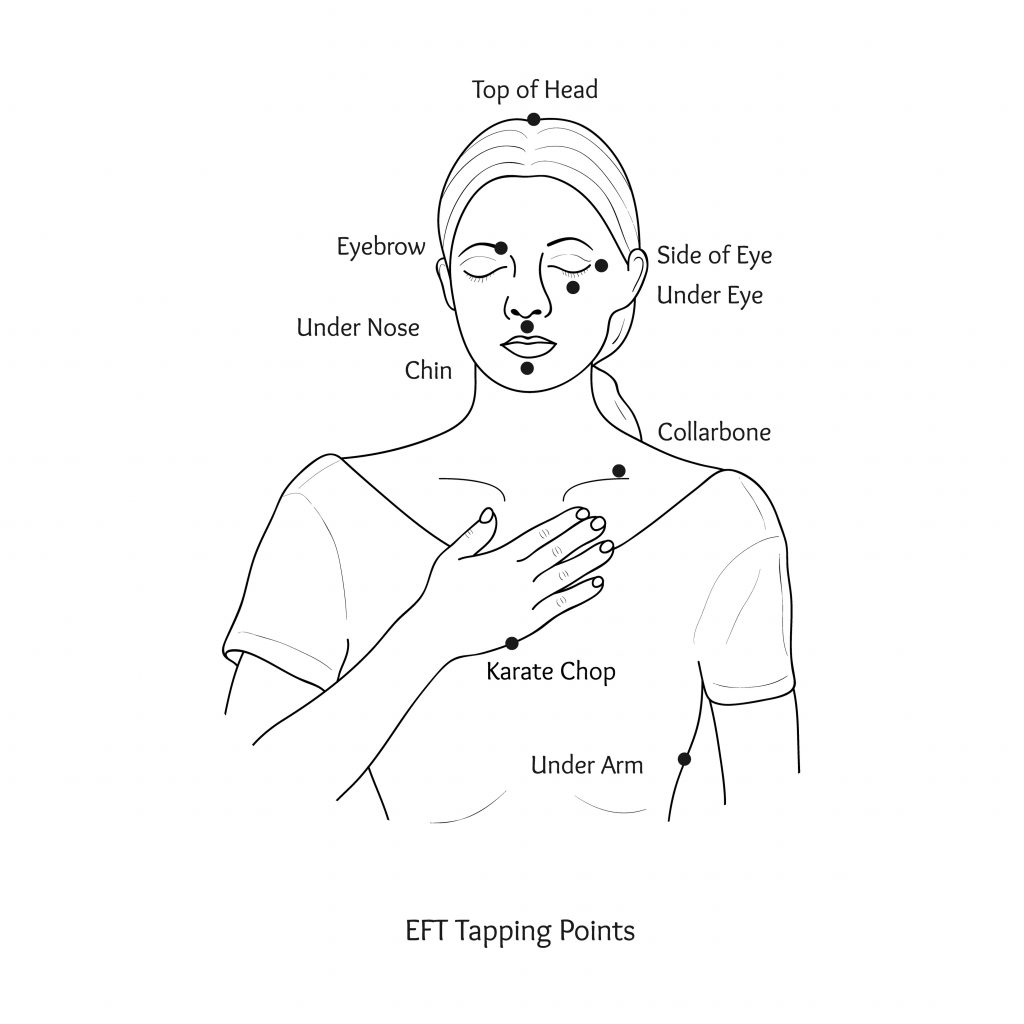What is Tapping and why it could help relieve what ails you. What kind of healing do you need? For anxiety and trauma, EFT Tapping (Emotional Freedom Techniques) is a mind/body self-supportive modality that you can do alone or with an accredited practitioner. It bridges Eastern and Western healing methods. EFT is rooted in the ancient principles of Acupuncture and the Meridian system, incorporating cognitive psychology as well as leading-edge brain science.
According to the developer of EFT, Gary Craig, tapping on different parts of the body helps balance energy and reduce physical and emotional pain. People can see an EFT practitioner for treatment or treat themselves using this technique.

What is Tapping
People often use EFT tapping when they are feeling anxious or stressed or when they have a specific issue that they would like to resolve. However, it may also be beneficial for a person before an event that they expect to cause stress or anxiety.
EFT enables us to release and transform uncomfortable or painful feelings like hurt, guilt, fear, anger, anxiety, judgment, self-doubt, overwhelm, procrastination, and physical pain. It offers the ability to effectively restore a sense of mind-body balance by releasing energies that have become trapped in the body as a result of suppressed emotions. When the energy of these stuck emotions is freed up, the brain and body can communicate, and healing takes place. Tapping acknowledges the connection of mind & body, recognizing that our mental and physical well-being are intimately linked to our emotional states.
How does EFT work?
The core idea behind EFT is that the cause of all negative emotions is a disruption in the body’s energy system. When energy gets stuck in the body, a variety of symptoms can appear. We can move the energy through the body’s meridian system ( invisible energy pathways through which life-energy flows), by tapping gently with your fingertips on the endpoints of a series of meridians, while tuning into the source of the blockage (the symptom, concern or issue). By focusing on the emotional upset, blocking beliefs, or physical pain, for example, the intense charge is neutralized or disappears. EFT is transformative by shifting the thoughts and beliefs that create our emotional experiences, including trauma and PTSD, physical symptoms, anxiety, fear, phobias.
While Tapping, we gain direct access to our energy system. By focusing on specific negative emotions and bodily sensations associated with these emotions, the stagnant energy can be released, and we can regain energy flow. EFT also engages the brain’s natural “relaxation response,” which appears to affect the amygdala, the stress center of our brain, as well as our memory center, the hippocampus, both of which allow us to evaluate whether something is a threat. Scientific studies have suggested that this pairing of mental and physical activity sends a calming signal to the amygdala, reducing unwanted negative emotions, instilling a sense of safety in the body itself.
How can EFT Tapping support our journey
One of the most empowering aspects of EFT is that it invites us to tap into our own body’s calming response. This calming response occurs by tapping on particular meridian endpoints, which interrupts the fight, flight, freeze response and turns on the relaxation response. This naturally promotes healing within while emotions such as fear, self-doubt, and limiting beliefs create negative responses in the body.
As I imagine we can understand from addiction, we might have learned to disassociate from our body and bodily sensations because the feelings might have been too painful to experience. As these coping mechanisms may have continued, one could have become good at self-numbing, using substances, food, spending, exercise, work or even the emotional attachment to our symptoms, as a pattern to divert ourselves from physical discomfort. EFT Tapping is an amazingly effective and efficient way to address what is happening in your mind and body so that you can empower yourself with greater ease and focus, while cultivating your own resilience and inner resources. Learn more about how to heal the brain. And other kinds of PTSD relieving techniques you can do at home.
How to Tap
In the basic tapping technique, you focus on what is distressing or concerning you, (what one might consider a negative emotion). For example, a fear, anxiety, a memory, an event, a physical symptom. While tuning in to your specific issue, you use your fingertips to lightly Tap (approximately 5 to 7 times) on each of the 8 specific Meridian points on the head and body. As you tap on each point, you are voicing in a single sentence or short reminder phrase, or, what the issue is. For example, “I’m frustrated about…,” “This frustration;” “This pain in my head,” “My fear this might not end;” “This sadness I’m feeling.” You are Tapping on whatever your inner dialogue or thought patterns are and giving it a voice. For more details:
NOTE: A common question when people begin Tapping is, “Why would I want to tap on something negative?” “Won’t that be instilling the negativity of how I feel?” The truth is that we are giving ourselves permission to voice and express what is true for us. It is a way to honor the inner dialogue of our subconscious mind. Quite often, my clients feel much after tapping on these negative statements. While it might seem counterintuitive, Tapping neutralizes the negative charge that these statements hold inside of us.
While anyone can find Tapping scripts using universal language that seems to support underlying issues, most people assume that similar issues will have the same contributing details. However, no two people experience the same details, or in the same way, so the result won’t necessarily be effective. That’s where a script might only touch the surface of the problem. What is worse, is that in the process, Tapping with a script can bring forward underlying traumas and deeper issues and unprepared to handle the unexpected, leading one to conclude that “EFT made things worse,” which is not the case. It was approaching something on the surface that was really a deeper issue without support. So Mindfulness is good to have. Working with a 1:1 Accredited Practitioner is a choice that can be beneficial and safe, while gaining effective results with the skill and knowledge to guide the process.
If you would like to discover more about EFT Tapping or explore further how EFT can support you with an EFTi Accredited Practitioner, please contact me at [email protected].
By Jude Weber Certified and Accredited EFT Tapping Practioner and Integrative Life Coach





















